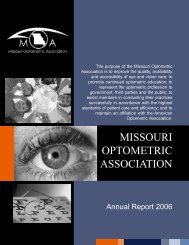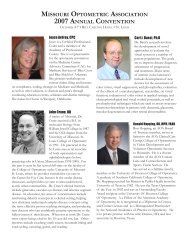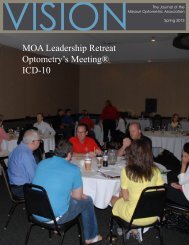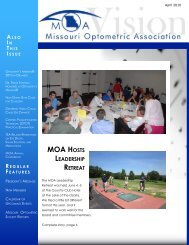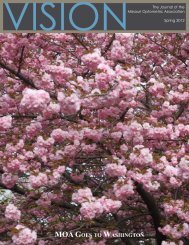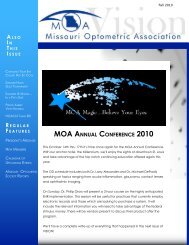Medical No Nos
Medical No Nos
Medical No Nos
- No tags were found...
You also want an ePaper? Increase the reach of your titles
YUMPU automatically turns print PDFs into web optimized ePapers that Google loves.
9/11/11Topical Steroids in Corneal Disease The transparency of the corneal stroma is dependenton: The parallel arrangement of the collagen fibers withinthe individual stromal lamellae The index of refraction of the tissues The water content of the stroma Steroids are used to help control inflammation andpreserve normal stromal architectureSteroids and Herpetic Keratitis• In the setting of Disciform keratitis or endotheliitis,predisone phosphate 0.12-1 % qd to qid depending onseverity of inflammation.• DO NOT use a steroid by itself, without trifluridineqid (if epithelium is involved), or without prophylactictrifluridine when using prednisone dose greater than0.12%.• Acyclovir 400 mg bid may be used prophylactically inplace of trifluridine.1
9/11/11Topical Steroids and Bacterial Keratitis DO NOT dose the steroid at a greater frequency thanthe topical antibiotic. DO NOT add the topical steroid until improvement isnoted in response to the antibiotic DO NOT add a topical steroid until topical antibioticshave been employed for a minimum of 48 – 72 hours.Topical Steroids and Corneal Thinning Topical steroids tend to further dehydrate the cornealstroma. Topical steroids can exacerbate stromal thinning. DO NOT use topical steroids without close monitoringif there is keratolysis (loss of stromal tissue) of greaterthan 75%.Sickle Cell Disease• Affects primarily people of African and Mediterraneandecent.• Results from mutations in the normal adulthemoglobin molecule (HgA), when valine issubstituted for glutamate at the 6 th position in thehemoglobin polypeptide chain.• Alters the dimensional structure of the molecule (HgS)and causes deformation of the RBC2
9/11/11Sickle Cell Disease Factors that affect sickling: Dehydration Vomiting Diarrhea Exercise without fluid replacement Decreased Oxygen tension Acidosis (Respiratory or metabolic)Sickle Cell Disease Lab Values: Hemoglobin and Hematocrit MCV: mean corpuscular volume MCHC: mean corpuscular hemoglobin concentration BUN: blood urea nitrogenSickle Cell Disease DO NOT administer diuretics (carbonic anhydraseinhibitors, (ie, Diamox)) to sickle cell patients(homozygous Hg SS). You can precipitate a sickle cellcrisis. DO NOT administer oral (ie, glycerin) or ivhyperosmotics (ie, mannitol) to sickle cell patients.You can precipitate a sickle cell crisis.3
9/11/11Beta Blocker’s in Eyecare• Are used to inhibit aqueous production by blocking beta-2 receptorson nonpigmented ciliary epithelium.• Side effects: bradycardia, bronchospasm, (contraindicated inasthmatics), hypotension, depression, lethargy, decreased libido,impotence.• DO NOT administer to asthmatics (reactive airway disease), orindividuals with chronic obstructive pulmonary disease (COPD) withreduced pulmonary function.• DO NOT administer to individuals with heart conduction anomalies(heart block), without a pacemaker, or other rhythm disturbanceswithout consulting the individual cardiologist or medical provider.Systemic hyperosmotic agents• Oral glycerin, and iv hyperosmotics such as mannitol,are used to lower IOP by pulling water out of thevitreous.• In doing so, the shift fluid from the intracellular, andinterstial compartment, to the vascular compartment.• From a cardiopulmonary perspective, volume overloadis a possibility, in compromised individuals.Systemic hyperosmotic agents• DO NOT give systemic hyperosmotics to individualswith Congestive Heart Failure (CHF).• DO NOT give systemic hyperosmotics to individualswith right-sided heart failure (cor pulmonale).• DO NOT give systemic hyperosmotics to individualsin renal failure.• DO NOT give systemic hyperosmotics to individualswith sickle cell disease.4
9/11/11Anticoagulant Therapy and AMDDietary Recommendations• Lutein and zeaxanthin are the two carotenoid pigments thatseem to be most important in guarding against AMD.• Found in green and yellow produce.• Zeaxanthin is found in yellow corn, yellow and orangepeppers, winter squash, carrots, yams, cantaloupes, peaches,oranges, mangos, and nectarines.• Lutein is found in green leafy vegetables such as the lettuce,spinach, and cabbage families (cabbage, broccoli, brusselsprouts, collard or mustard greens, kale), and parsley andit’s relatives (celery, cilantro, dill and fennel).Anticoagulant Therapy and AMDDietary Recommendations• Many of these same foods are contraindicated in individuals onanticoagulant therapy with Warfarin (coumadin).• Foods to avoid while on anticoagulant therapy because they arerich in Vitamin K and therefore reduce the effect of coumadin :– Kale– Spinach– Brussel sprouts– Collard greens– Mustard greens– Chard– Green teaAnticoagulant Therapy and AMDDietary Recommendations DO NOT recommend these foods in patients onanticoagulant therapy with warfarin or coumadin. Youcan instead advise them to utilize direct supplementswhich do not contain vitamin K.5



